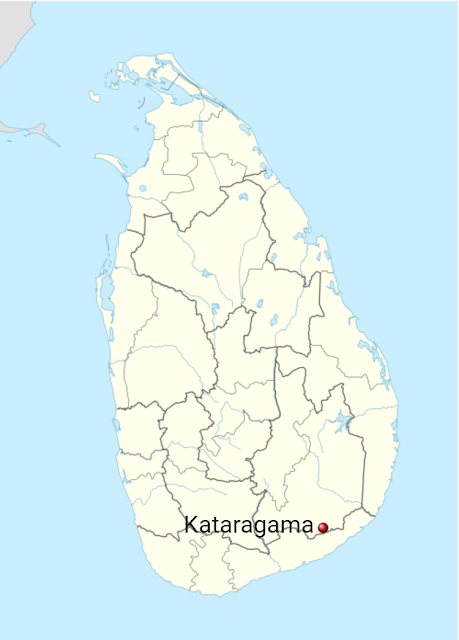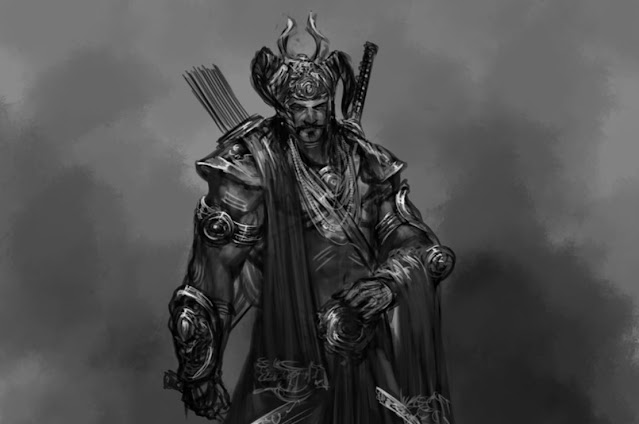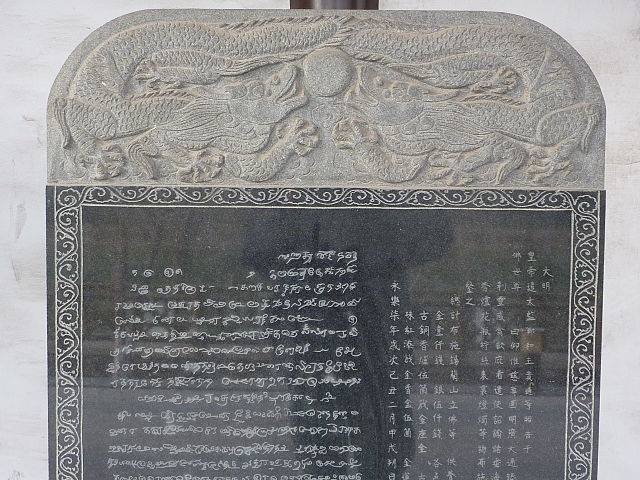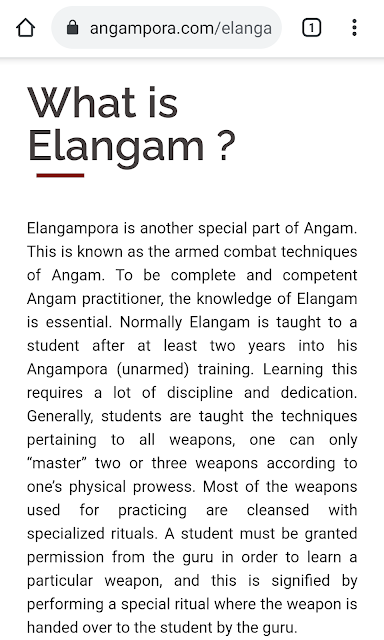For a while now, I had been inquisitive about the ANGAMPORA - THE MARTIAL ART OF SRI LANKA.
This Martial Art had caught my attention a few months ago, and I kept Researching on this subject.
FINALLY - I HAVE CONCLUDED THAT ANGAMPORA IS THE FALSE PRIDE OF THE SINHALESE..!
I checked about Angamporas History and the Rituals practiced in Angampora, in one of the Angampora websites, which you could clearly see below:
It clearly states that the Ancient Fighting Art of Angampora was protected by TAMIL KING RAVANA and TAMIL GOD KATARAGAMA
TAMIL KING RAVANA AND ANGAMPORA:
We have already previously seen that RAVANA was a TAMIL KING, and the RAVANA'S MEDICAL SYSTEM called THAI (THANI) TAMIL CHINTHAMANI MEDICINE IS WRITTEN ONLY IN TAMIL LANGUAGE. THERE IS NO OTHER RECORD OF RAVANA'S MEDICINE IN SANSKRIT LANGUAGE OR SINHALA LANGUAGE TO CLAIM THAT RAVANA WAS A BRAHMIN OR A SINHALESE.
RAVANA WAS A TAMIL KING. RAVANA WAS NEITHER BRAHMIN NOR A SINHALA
SRI LANKA: A PURELY TAMIL KINGDOM
Till today in Kanyakumari and other Southern districts in Tamil Nadu, they teach RAVANA'S SCHOOL OF MARTIAL ARTS (VARMAKKALAI) AND RAVANA'S MEDICINE CALLED "TAMIL CHINTHAMANI MARUTHUVAM"
Please check out this YouTube Channel, where Master Pushparaj, from Marthandam is teaching TAMIL CHINTHAMANI MARUTHUVAM AND RAVANA'S VARMAKKALAI MARTIAL ARTS.
TAMIL GOD MURUGAN (KATARAGAMA) AND ANGAMPORA:
Fine, we know for sure now that RAVANA was a TAMIL KING. The other God who protects Angampora is "KATARAGAMA DEVIYO" who is NONE OTHER THAN TAMIL GOD - MURUGAN
IN INDIA, MURUGAN WORSHIP IS NOT FOUND BEYOND TIRUPATHI OR BY THE BRAHMINS (EVEN IN TAMIL NADU) JUST LIKE THE SAPTHA KANNI AND SAPTHA RISHI WORSHIP.
 | |
| The God Kataragama, worshiped by the Sinhalese is the TAMIL GOD - MURUGAN |
 |
| The city of Refuge of Tamils (Murugans Descendants) |
There is a city called KATARAGAMA in the Southern most Part of Sri Lanka, named after Kataragama in Sinhala and KARTHIKEYA in TAMIL.
KATHI means Sun's Rays, or Enlightenment in Tamil and Kaamam means Love and Village.
It is said that Tamil God Murugan, was the Chiefest Guru of ALL Siddhars, including Agathiyar, and he was an ENLIGHTENED person. Similarly, Murugan found the Love of his life, called Valli in South Sri Lanka
TAMIL INSCRIPTIONS IN SOUTH SRI LANKS TILL 14th CENTURY CE, PROVES THIS FACT.!
This was the Inscription given as proof by the Chinese general Zheng He, the Ming General of 14th Century CE, which clearly states that
A TAMIL KING NAMED AZHAGESARAN , RULED OVER SOUTH SRI LANKA AND THAT THE POPULATION WAS A TAMIL MAJORITY, KNOWN FROM A TAMIL TEXT (NO SINHALA TEXT FOUND) IN THAT STONE INSCRIPTION
THIS INSCRIPTION PROVES THAT TAMIL WAS THE LINGUA FRANCA OF NATIVE OF SOUTH SRI LANKA AND THE MASSES EVEN IN 1410 CE, TILL THE END OF 16th CENTURY AD, UNTIL THE EUROPEAN INVADERS TOOK OVER.!
AGATHIYAR'S CONTRIBUTION TO SRI LANKAN ANGAMPORA:
While watching one of the Famous Angampora YouTube channel, I happened to notice this
IT CLEARLY STATES THAT THE STAFF/ STICK FIGHTING METHODS OF ANGAMPORA WERE ENDOWED TO ANGAMPORA BY AGASTHI MUNI
While searching for more details about Agathiyar's Staff fighting methods, I found out that Agathiyar has written a lot about the Staff Fighting methods in a Palm Leaf Manuscript titled "AGATHIYAR KAMPU SOOTHIRAM" which is written purely and only in TAMIL LANGUAGE
 |
| Confessions of an Angampora Artist, that Stick Fighting of Angampora was from Agathiyar |
ANGAMPORA AND THE CHOLAS CONTRIBUTION:
The Ancient Record of the Cholas called Valamkaimalai, which speaks about the Right Hand People, known as Puja Valiya in Mahavamsa, speaks about the Two branches of the Chola Kingdoms Army.
One is the Idamkaiyar (Left Hand people), and the other is the Valamkaiyar (Right Hand people)
THIS POEM BELOW, WHICH SPEAKS ABOUT ILLANGAMPORA (ELANGAMPORA) IS FORM VALAMKAIMALAI:
This passage from the Chola Kings Record states that the art of ILLANGAM (ELANGAM) WAS FROM THE PANDIYAN KINGDOM OF KORKAI & MADURAI, AND THOSE WHO PRACTICE THIS ARE WORSHIP BADRA KALI.!
SILAMBAM (THEKKAN KALARI) AND ANGAMPORA:
Though many people today be it practitioners, researchers on martial arts or just people who view the Martial Arts of Kalari Payat and Angampora, see a lot of similarities between these two arts, it should actually be noted that Angampora is closely related to Kuthu Varisai in Empty Hand Fighting System and closely related to Silambam in Weaponry Fighting Techniques.
ANGAMPORA VIDEOS:
In the case of Kalari Payat, Angampora is closely related, but also distinct from the Thekkan Kalari style, known as Adimurai in Trivandrum and Kanyakumari districts.
Secondly, both Varmakalai (Kuthu Varisai & Silambam) of Tamil Nadu and Angampora of Sri Lanka has got Karthikeya (Katharagama), Ravanan (Ravana) and Agathiyar (Agasthi muni) as the progenitors of their Martial Arts,
CONTRARY TO THE MYTHOLOGICAL STORY OF PARASHURAMA WHO FOUNDED THE VADAKKAN STYLE KALARI PAYAT.
Thirdly, the Concept of Cheena Ati is present in Varmakalai of Tamil Nadu and Angampora of Sri Lanka, which concept is absent in the Vadakkan Kalari Payat tradition of Kerala.
CHEENA ATI FROM TAMIL NADU:
CHEENA ATI IN ANGAMPORA FROM SRI LANKA:
ANGAMPORA AND VADAKKAN KALARI PAYAT:
By external appearance, both, the Vadakkan style of Kalari Payat and Angampora, share a lot of similarities on their external aspects.
The Kalari Kalam and the Angam Kalam both are made of Mud Pit and below the Ground Level
The Meypayattu in Vadakkan Kalari Payat, shares a lot in common with the Angampora Physical Exercises
The Low deep Stances and High Jumping techniques and Circular movements are common in both Angampora and Vadakkan Kalari Payat.
VADAKKAN KALARI DOCUMENTARY:
ANGAMPORA DOCUMENTARY VIDEO:
MARMA KALA (KERALA) & MARU KALA (SRI LANKA):
MARMA POINTS OF KALARI PAYAT ARE BASED AYURVEDIC MEDICAL SYSTEM
HELA WEDAKAMA OIL MASSAGE:
VARMAKALAI (TAMIL NADU) & MARU KALA (SRI LANKA):
VARMAKALAI IS BASED ON TAMIL SIDDHA MEDICINE AND TAMIL CHINTHAMANI MEDICINE
VARMAKALAI OIL MASSAGE:
HELA WEDAKAMA MASSAGE:
SO, COMING TO THE END POINT - ANGAMPORA IS NONE OTHER THAN THE MARTIAL ART OF KUTHU VARISAI AND SILAMBAM, GIVEN BY TAMIL GOD MURUGAN, TAMIL SAGE AGATHIYAR AND TAMIL KING RAVANA.
ANGAMPORA - AN ANCIENT WAR ART OF TAMILIANS; IS THE FALSE PRIDE OF THE SINHALESE...!!!!










